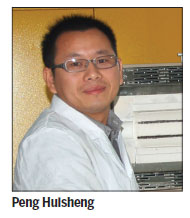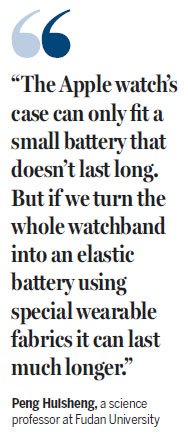'Fixing' Apple watch with a better battery
Updated: 2015-03-20 12:20
By Wang Ying in Shanghai(China Daily USA)
|
||||||||
A Chinese professor is working on a solution to the short battery life of the Apple watch, and he hopes to find investors for his potentially game-changing product in Shanghai.
The wearable device, which is due to be released on April 24, has invited derision due to its stingy 18-hour battery life despite offering a slew of attractive functions such as its ability to track the user's health.
But newly developed super-capacitor and lithium-ion batteries developed by a research group in Shanghai may help solve the problem. The batteries are made from carbon nanotubes that can be woven together like fabric, or strands of human hair, to prolong the watch's battery life, the group said.
The project is being spearheaded by Peng Huisheng, a science professor from Fudan University's department of macromolecular science. Fudan is one of China's top universities.
"Lithium-ion batteries are widely used nowadays but they gradually lose stability, which runs down the actual battery life," said Gao Mingxia, a professor from Zhejiang University.
The trick to fixing this problem is to weave the new battery 'hairs' into the fabric of the wristband, according to Yang Junhe, a professor from the University of Shanghai for Science and Technology, who was involved in the research.
"The Apple watch's case can only fit a small battery that doesn't last long. But if we turn the whole watchband into an elastic battery using special wearable fabrics it can last much longer," said Peng.
"It's theoretically possible," said Gao. "The wearable fabric can be more powerful because of its high density."
Peng came up with the idea of developing wearable fabrics by weaving in solar cells and batteries in 2007. He set up a 28-member research group in late 2008 at Fudan.
"The original idea was to make fabric-based solar cells that can generate solar power and store the power in fabric-shaped cells," he said.
The cells would then be woven into clothes, watchbands, bags or even tents, he added.
In 2010, Peng's group made the idea a reality by putting solar cells into batteries. They have been working on the application of wearable fabrics since 2012.
"We've been approached by many companies that are interested in commercializing this," said Peng, adding that one of Apple's top rivals has also expressed interest.
The fabrics made of carbon nanotubes are expected to be available as super-capacitor and lithium-ion batteries in about three years, he said. The former has a greater storage capacity.
The solar-powered cells will be ready for mass production within a decade, he added.
Yang said carbon nanotubes are expensive to manufacture but the price will shear down once the batteries enter mass production.
wang_ying@chinadaily.com.cn


(China Daily USA 03/20/2015 page7)

 How much do world leaders earn?
How much do world leaders earn?
 Daredevil ropejumpers leap 200 meter off cliff
Daredevil ropejumpers leap 200 meter off cliff
 Harley motorcade shows up in Boao, Hainan
Harley motorcade shows up in Boao, Hainan
 Ming art sets Christie's high
Ming art sets Christie's high
 Stolen-phone bromance blossoms in China
Stolen-phone bromance blossoms in China
 Prince Charles, Camilla get royal tour of Washington
Prince Charles, Camilla get royal tour of Washington
 Should selfie sticks be banned?
Should selfie sticks be banned?
 Tunisians demonstrate against terrorism
Tunisians demonstrate against terrorism
Most Viewed
Editor's Picks

|

|

|

|

|

|
Today's Top News
Yahoo to exit from Chinese mainland market
US sends 'green' mission to China
Sticking it to the selfie stick
China's eco-friendly companies stand to gain
China's global image on rise
3 killed in shooting at California convenience store
More Chinese film companies tap into Hollywood
Microsoft tackles China piracy with free upgrade to Windows 10
US Weekly

|

|







